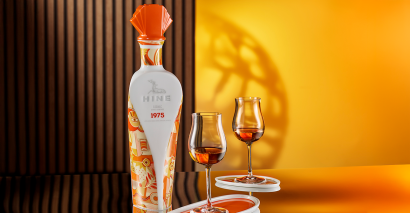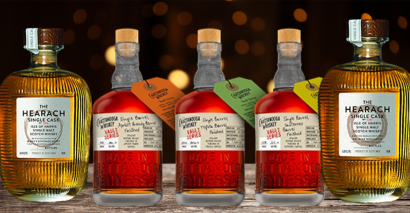
Review: Heaven Hill Grain to Glass Series Turns to Chinquapin Oak
This rarely seen wood type is used for the full maturation of these whiskeys
November 20, 2025 –––––– Danny Brandon
Heaven Hill debuted its Grain to Glass annual series in the summer of 2024, starting with a trio of whiskeys—a bourbon, a rye, and a wheated bourbon—distilled in 2017. Last summer came the 2025 version of that threesome, distilled in 2018. All six of these expressions have won high praise, scoring in the 92-94 point range with Whisky Advocate’s tasting panel. Now the Grain to Glass series has headed in a new direction, exploring the use of wood with a bourbon, a wheater, and a rye fully matured in chinquapin oak.
Exploration of Oak
Chinquapin is a type of white oak that’s native to North America, primarily in the Central and Northeast U.S. and some areas of Canada. It’s a close cousin of American white oak (Quercus alba), often used to make whiskey barrels, with some small differences: The Chinquapin is shorter than the American white oak, topping out at around 70 feet compared to 100 feet, and tends to grow in slightly drier soil. It hasn’t often been used for whisky maturation, though there has been more of it in recent years, with releases like Bomberger’s Declaration 2025, Meikle Tòir The Chinquapin One, Woodford Reserve Sweet Oak, and Angel’s Envy Triple Oak.
Heaven Hill has used chinquapin oak in the past, mainly to finish some smaller-scale distillery exclusives. But these new releases mark the first time the distillery has used it for full maturation. This project started seven years ago, when master distiller Conor O’Driscoll started collaborating with Andrew Wiehebrink, who heads up R&D for Independent Stave Company. When the pair got to talking about the possibility of making a barrel-focused spin-off for the Grain to Glass series, O’Driscoll says chinquapin felt like a natural first step—explaining that it was a sort of “safe play” considering how similar the barrels are to American white oak, with chinquapin offering a comparable array of flavors with slightly more oak spice. “It’s not a huge departure from aging in white oak,” O’Driscoll explains. “But it is a nice tangent and exploration of what it could be.”
In terms of liquid, the new chinquapin releases are similar to the Grain to Glass 2025 counterparts: all distilled in 2018 from identical mashbills, including a high-starch hybrid corn variety called Beck’s 6225, and aged at least 6 years. The main difference is in the wood, with these new releases being aged entirely in chinquapin oak rather than American white oak. Since the chinquapin release is meant to showcase the differences between the oaks, O’Driscoll specifically chose to use a No.-3 char for all of the 2025 Grain to Glass releases to minimize the variables and highlight the flavor differences. He says that, if multiple levels had been used, then it would be harder for drinkers to know whether those flavor differences were coming from the oaks themselves, or from how they were charred. The team first started tasting the whiskey at 3 years old, then annually, and later every six months, to track its progression.
The chinquapin whiskeys were entered into the barrel at a notably low 107 proof compared to the typical 125 entry proof. That decision seems to introduce a new variable into the mix, as entry proof often has a direct impact on how a whisky tastes, but it serves two main purposes: breaking up some of the heavier oak and spice notes brought out by the chinquapin oak, and paying homage to the original low entry proof used by Heaven Hill in its early days. O’Driscoll claims you can taste the difference it made when you sip the chinquapin expressions alongside the ones aged in American white oak.
Heaven Hill expects the Specialty Barrel Series to be an annual release, like the core Grain to Glass releases. The plan is three expressions per batch, though O’Driscoll says that could change depending on the focal point of the particular batch’s experimentation. The focus will continue to be on primary maturation in interesting oak casks, with no current plans for any cask-finished expressions. “We’ve done finishes before,” O’Driscoll notes. “But our DNA, our strength, is in full maturation.” As for what exactly those interesting barrels might be, O’Driscoll confirmed that he and the team have been working with several different types of European oak—pointing specifically to French and Slovakian, which are expected to be released over the next few years.
How Do They Taste?
These whiskeys scored very well, though not quite as well as the highest-scoring original six Grain to Glass releases, with some of our tasters finding them more dry than the previous expressions. Here are the scores and tasting notes.
Heaven Hill 2018 Grain to Glass Specialty Barrel Series Chinquapin Aged Rye (2025)
Score: 92
ABV: 53.5%
SRP: $130
Luscious cherry accented by dark chocolate-covered espresso beans
Heaven Hill 2018 Grain to Glass Specialty Barrel Series Chinquapin Aged Wheated Bourbon (2025)
Score: 91
ABV: 52.5%
SRP: $130
Cocoa cereal milk wrapped around hearty, bracing wood
Heaven Hill 2018 Grain to Glass Specialty Barrel Series Chinquapin Aged Bourbon (2025)
Score: 89
ABV: 52.5%
SRP: $130
Dry and ashy, with some sugared black coffee and dark chocolate against bitter oak




